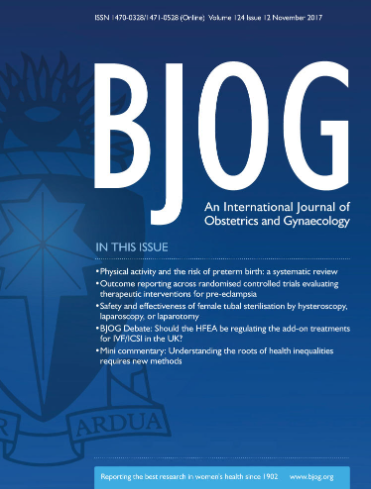Post-Operative Pain After Pelvic Organ Prolapse Surgery (POPPOP): A Double Blind Randomised Multicentre Study to Assess the Effect of Local Anaesthesia During Vaginal Hysterectomy
Abstract
Objective
To compare local anaesthetic with adrenaline (LAA) with normal saline for hydrodissection at vaginal hysterectomy.
Design
A double-blind, two parallel group multicentre randomised controlled trial (RCT) was planned.
Setting
217 women undergoing vaginal hysterectomy were screened in the five participating centres between March 2015 and December 2018.
Population
156 patients were recruited.
Methods
Patients were randomised to Bupivacaine 0.25%/0.5% with adrenaline 1:200000 vesus normal saline. They completed baseline ‘pre-operation’, ‘same day 3–6 h post-op’ and ‘morning after surgery’ short-form McGill pain questionnaire (SFMcGill).
Main Outcome Measures
Primary endpoint was post-operative pain measured using SFMcGill. Secondary endpoints included estimated blood loss (EBL), ease of dissection, severity of ooze, change in pre- and post-operative haemoglobin, operating time, duration of inpatient stay and incidence of post-operative morbidity.
Results
There were no demographic differences between the groups. LAA was associated with significantly smaller increases in pain scores compared to placebo, both between pre-operative and same-day post-operative (7.105 p < 0.001) and to the next day post-operative (1.334 p < 0.001).
Use of placebo infiltrate was associated with increased intra-operative bleeding (difference in EBL 110 mL p < 0.001), increased severity of ooze (VAS difference 5.01 p < 0.001), and more difficult dissection (VAS difference 2.96 p < 0.001). There were no differences in pre-operative or post-operative measures of Hb, PCV, or post-operative analgesia (p > 0.05). There were significantly more complications in the placebo arm (5 vs. 0, p = 0.02).
Conclusions
This multicentre-RCT demonstrated the value of LAA compared to normal saline as a paracervical infiltrate during vaginal hysterectomy under general anaesthesia: reduced intra-operative blood loss, improved ease of dissection, decreased same and next day pain scores and complications.

 求助内容:
求助内容: 应助结果提醒方式:
应助结果提醒方式:


